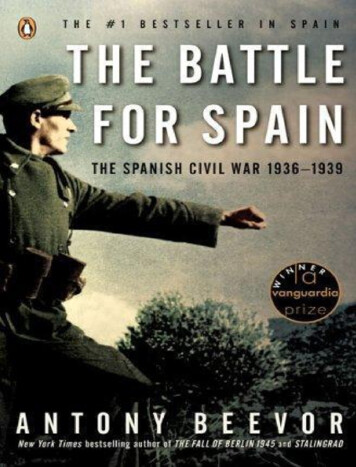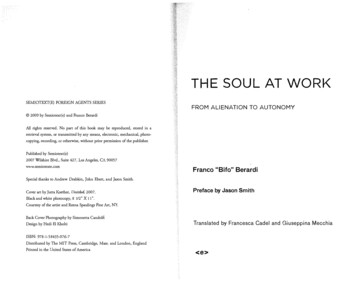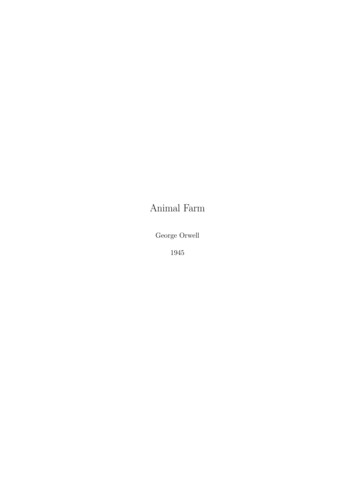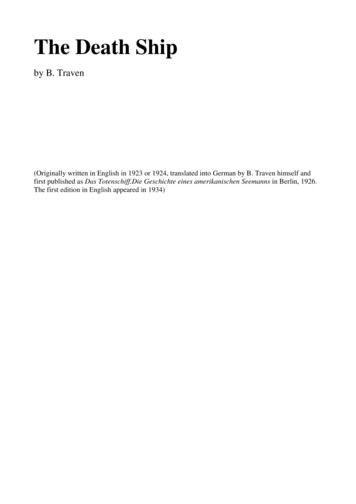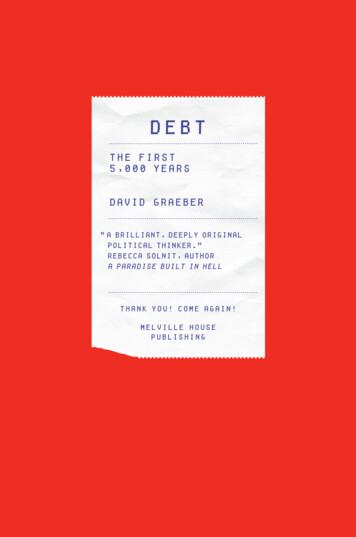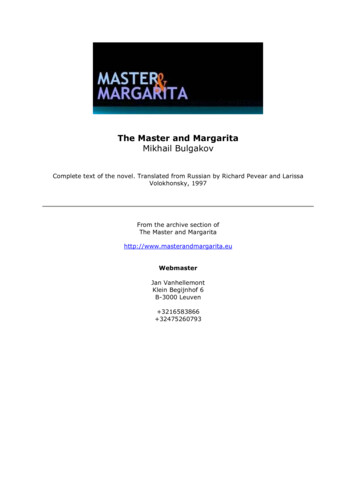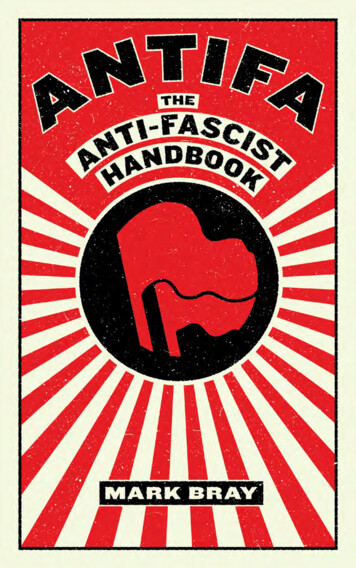
Transcription
A NTIFA
ANTIFACopyright 2017 by Mark BrayFirst published by Melville House Publishing, September 2017Melville House Publishing 8 Blackstock Mews46 John Street and IslingtonBrooklyn, NY 11201London N4 Photo of Dax graffiti mural courtesy of WolksWriterzISBN: 978-1-61219-704-3Designed by Fritz MetschA catalog record for this book is availablefrom the Library of Congress
To the Jews of Knyszyn, Poland
CONTENTSIntroduction . . . . . . . . . . . . . . . . . . . . xiOne: ¡No Pasarán!: Anti-Fascism Through 1945 . . . . . . 3Two: “Never Again”: The Development of ModernAntifa, 1945–2003 . . . . . . . . . . . . . . . . 39Three: The Rise of “Pinstripe Nazis” and Anti-FascismToday . . . . . . . . . . . . . . . . . . . . . 77Four: Five Historical Lessons for Anti-Fascists . . . . . 129Five: “So Much for the Tolerant Left!”: “No Platform”and Free Speech . . . . . . . . . . . . . . . . 143Six: Strategy, (Non)Violence, and Everyday Anti-Fascism 167Conclusion: Good Night White Pride (or WhitenessIs Indefensible) . . . . . . . . . . . . . . . . . 207 Appendix A: Advice from the Anti-Fascists of the Pastand Present to Those of the Future . . . . . . . . 213Appendix B: Select Works on North American andEuropean Anti-Fascism . . . . . . . . . . . . . 223Notes . . . . . . . . . . . . . . . . . . . . . . 227
“Fascism is not to be debated, it is to be destroyed!”— Bu enav en t u r a Du r ru t i
INTRODUCTIONIwish there were no need for this book. But someone burneddown the Victoria Islamic Center in Victoria, Texas, hoursafter the announcement of the Trump administration’s Muslim ban. And weeks after a flurry of more than a hundred proposed anti-LGBTQ laws in early 2017, a man smashed throughthe front door of Casa Ruby, a Washington, D.C., transgenderadvocacy center, and assaulted a trans woman as he shouted“I’m gonna kill you, faggot!” A day after Donald Trump’s election, Latino students at Royal Oak Middle School in Michigan were brought to tears by their classmates’ chants of “Buildthat wall!” And then in March, a white-supremacist army veteran who had taken a bus to New York to “target black males”stabbed a homeless black man named Timothy Caughman todeath. That same month, a dozen tombstones were toppledand defaced in the Waad Hakolel Jewish cemetery in Rochester, New York. Among those resting in peace in Waad Hakolel is my grandmother’s cousin Ida Braiman, who was fatallyshot by an employer months after she arrived in the UnitedStates from Ukraine as she stood on a picket line with otherimmigrant Jewish garment workers in 1913. The recent spate ofJewish cemetery desecrations in Brooklyn, Philadelphia, andelsewhere occurred under the Trump administration, whosestatement on the Holocaust omitted any reference to Jews,whose press secretary denied that Hitler gassed anyone, andwhose chief advisor was one of the most prominent figuresof the notoriously anti-Semitic alt-right. As Walter Benjamin
xiiINTRODUCTIONwrote at the apogee of interwar fascism, “even the dead will notbe safe from the enemy if he wins.”1Despite a resurgence of white-supremacist and fascisticviolence across Europe and the United States, most considerthe dead and the living to be safe because they believe fascism to be safely dead—in their eyes, the fascist enemy lostdefinitively in 1945. But the dead were not so safe when Italianprime minister Silvio Berlusconi described spending time inMussolini’s prison camps as a “vacation” in 2003 or the FrenchFront National (National Front) politician Jean-Marie Le Pencalled Nazi gas chambers a mere “detail” of history in 2015.Neo-Nazis who in recent years have littered the sites of formerJewish ghettoes in Warsaw, Bialystok, and other Polish citieswith white-power graffiti know very well how their Celticcrosses target the dead as well as the living. The Haitian anthropologist Michel-Rolph Trouillot cautions us that “. . . thepast does not exist independently from the present . . . Thepast—or more accurately, pastness—is a position. Thus, in noway can we identify the past as past.”2This book takes seriously the transhistorical terror offascism and the power of conjuring the dead when fightingback. It is an unabashedly partisan call to arms that aims toequip a new generation of anti-fascists with the history andtheory necessary to defeat the resurgent Far Right. Basedon sixty-one interviews with current and former anti-fascistsfrom seventeen countries in North America and Europe, itexpands our geographical and temporal outlook to contextualize opposition to Trump and the alt-right within a muchwider and broader terrain of resistance. Antifa is the firsttransnational history of postwar anti-fascism in English andthe most comprehensive in any language. It argues that militant anti-fascism is a reasonable, historically informed response to the fascist threat that persisted after 1945 and thathas become especially menacing in recent years. You maynot walk away from this book a convinced anti-fascist, but at
INTRODUCTIONxiiileast you will understand that anti-fascism is a legitimate political tradition growing out of a century of global struggle.W H AT I S A N T I - FA S C I S M ?Before analyzing anti-fascism, we must first briefly examine fascism. More than perhaps any other mode of politics, fascism isnotoriously difficult to pin down. The challenge of defining fascism stems from the fact that it “began as a charismatic movement” united by an “experience of faith” in direct oppositionto rationality and the standard constraints of ideological precision.3 Mussolini explained that his movement did “not feel tiedto any particular doctrinal form.”4 “Our myth is the nation,” heasserted, “and to this myth, to this grandeur we subordinate allthe rest.”5 As historian Robert Paxton argued, fascists “rejectany universal value other than the success of chosen peoples ina Darwinian struggle for primacy.”6 Even the party platformsthat fascists put forward between the world wars were usuallytwisted or jettisoned entirely when the exigencies of the pursuitof power made those interwar fascists uneasy bedfellows withtraditional conservatives. “Left” fascist rhetoric about defendingthe working class against the capitalist elite was often amongthe first of their values to be discarded. Postwar (after WorldWar II) fascists have experimented with an even more dizzyingarray of positions by freely pilfering from Maoism, anarchism,Trotskyism, and other left-wing ideologies and cloaking themselves in “respectable” electoral guises on the model of France’sFront National and other parties.7I agree with Angelo Tasca’s argument that “to understandFascism we must write its history.”8 Yet, since that history willnot be written here, a definition will have to suffice. Paxtondefines fascism as:. . . a form of political behavior marked by obsessive preoccupation with community decline, humiliation, or
xivINTRODUCTIONvictimhood and by compensatory cults of unity, energy,and purity, in which a mass-based party of committednationalist militants, working in uneasy but effectivecollaboration with traditional elites, abandons democratic liberties and pursues with redemptive violenceand without ethical or legal restraints goals of internalcleansing and external expansion.9When compared to the challenges of defining fascism, getting ahandle on anti-fascism may seem like an easy task at first glance.After all, literally, it is simply opposition to fascism. Some historians have used this literal, minimalist definition to describeas “anti-fascist” a wide variety of historical actors, including liberals, conservatives, and others, who combated fascist regimesprior to 1945. Yet, the reduction of the term to a mere negation obscures an understanding of anti-fascism as a method ofpolitics, a locus of individual and group self-identification, anda transnational movement that adapted preexisting socialist,anarchist, and communist currents to a sudden need to reactto the fascist menace. This political interpretation transcendsthe flattening dynamics of reducing anti-fascism to the simplenegation of fascism by highlighting the strategic, cultural, andideological foundation from which socialists of all stripes havefought back. Yet, even within the Left, debates have raged between many socialist and communist parties, antiracist NGOs,and others who have advocated a legalistic pursuit of antiracistor anti-fascist legislation and those who have defended a confrontational, direct-action strategy of disrupting fascist organizing. These two perspectives have not always been mutuallyexclusive, and some anti-fascists have turned to the latter option after the failure of the former, but in general this strategicdebate has divided leftist interpretations of anti-fascism.This book explores the origins and evolution of a broad antifascist current that exists at the intersection of pan-socialistpolitics and direct-action strategy. This tendency is often called
INTRODUCTIONxv“radical anti-fascism” in France, “autonomous anti-fascism” inGermany, and “militant anti-fascism” in the United States, theU.K., and Italy, among today’s antifa (the shorthand for antifascist in many languages).10 At the heart of the anti-fascistoutlook is a rejection of the classical liberal phrase incorrectlyascribed to Voltaire that “I disapprove of what you say, but Iwill defend to the death your right to say it.”11 After Auschwitzand Treblinka, anti-fascists committed themselves to fightingto the death the ability of organized Nazis to say anything.Thus, anti-fascism is an illiberal politics of social revolutionism applied to fighting the Far Right, not only literal fascists. As we will see, anti-fascists have accomplished this goalin a wide variety of ways, from singing over fascist speeches,to occupying the sites of fascist meetings before they couldset up, to sowing discord in their groups via infiltration, tobreaking any veil of anonymity, to physically disrupting theirnewspaper sales, demonstrations, and other activities. Militant anti-fascists disagree with the pursuit of state bans against“extremist” politics because of their revolutionary, anti-statepolitics and because such bans are more often used against theLeft than the Right.Some antifa groups are more Marxist while others are moreanarchist or antiauthoritarian. In the United States, most havebeen anarchist or antiauthoritarian since the emergence ofmodern antifa under the name Anti-Racist Action (ARA) in thelate eighties. To some extent the predominance of one factionover the other can be discerned in a group’s flag logo: whetherthe red flag is in front of the black or vice versa (or whetherboth flags are black). In other cases, one of the two flags can besubstituted with the flag of a national liberation movement ora black flag can be paired with a purple flag to represent feminist antifa or a pink flag for queer antifa, etc. Despite such differences, the antifa I interviewed agreed that such ideologicaldifferences are usually subsumed in a more general strategicagreement on how to combat the common enemy.
xviINTRODUCTIONA range of tendencies exist within that broader strategicconsensus, however. Some antifa focus on destroying fascistorganizing, others focus on building popular communitypower and inoculating society to fascism through promotingtheir leftist political vision. Many formations fall somewherein the middle of this spectrum. In Germany in the 1990s, a debate emerged in the autonomous anti-fascist movement overwhether antifa was mainly a form of self-defense necessitatedby attacks from the Far Right or a holistic politics, often called“revolutionary anti-fascism,” that could form the foundationof the broader revolutionary struggle.12 Depending on localcontexts and politics, antifa can variously be described as akind of ideology, an identity, a tendency or milieu, or an activity of self-defense.Despite the various shades of interpretation, antifa shouldnot be understood as a single-issue movement. Instead, it issimply one of a number of manifestations of revolutionarysocialist politics (broadly construed). Most of the anti-fascistsI interviewed also spend a great deal of their time on otherforms of politics (e.g., labor organizing, squatting, environmental activism, antiwar mobilization, or migrant solidaritywork). In fact, the vast majority would rather devote their timeto these productive activities than have to risk their safety andwell-being to confront dangerous neo-Nazis and white supremacists. Antifa act out of collective self-defense.The success or failure of militant anti-fascism often depends on whether it can mobilize broader society to confrontfascists, as occurred so famously with London’s 1936 Battle ofCable Street, or tap into wider societal opposition to fascism toostracize emerging groups and leaders.At the core of this complex process of opinion-making isthe construction of societal taboos against racism, sexism,homo phobia, and other forms of oppression that constitute thebedrocks of fascism. These taboos are maintained through adynamic that I call “everyday anti-fascism” (Chapter 6).
INTRODUCTIONxviiFinally, it is important not to lose sight of the fact that antifascism has always been just one facet of a larger struggleagainst white supremacy and authoritarianism. In his legendary 1950 essay “Discourse on Colonialism,” the Martiniquanwriter and theorist Aimé Césaire argued convincingly that“Hitlerism” was abhorrent to Europeans because of its “humiliation of the white man, and the fact that [Hitler] appliedto Europe colonialist procedures which until then had beenreserved exclusively for the Arabs of Algeria, the ‘coolies’ ofIndia, and the ‘niggers’ of Africa.”13 Without in any way diminishing the horror of the Holocaust, to a certain extent we canunderstand Nazism as European colonialism and imperialismbrought home. The decimation of the indigenous populationsof the Americas and Australia, the tens of millions who diedof famine in India under British rule, the ten million killed byBelgian king Leopold’s Congo Free State, and the horrors oftransatlantic slavery are but a sliver of the mass death and societal decimation wrought by European powers prior to the riseof Hitler. Early concentration camps (known as “reservations”)were set up by the American government to imprison indigenous populations, by the Spanish monarchy to contain Cubanrevolutionaries in the 1890s, and by the British during the BoerWar at the turn of the century. Well before the Holo caust, theGerman government had committed genocide against theHerero and Nama people of southwest Africa through the useof concentration camps and other methods between 1904 and1907.14For this reason, it is vital to understand anti-fascism as asolitary component of a larger legacy of resistance to white supremacy in all its forms. My focus on militant anti-fascism is inno way intended to minimize the importance of other formsof antiracist organizing that identify with anti-imperialism,black nationalism, or other traditions. Rather than imposingan anti-fascist framework on groups and movements that conceive of themselves differently, even if they are battling the
xviiiINTRODUCTIONsame enemies using similar methods, I focus largely on groupsthat self-consciously situate themselves within the anti-fascisttradition.***Since World War II has become the emblematic moral dramaof the Western world, “historical” anti-fascism has managedto accrue a certain degree of legitimacy despite being over shadowed by the definitive role of the Allied armies in defeatingthe Axis powers. Still, with the defeat of Hitler and Mussolini,anti-fascism’s raison d’être was widely thought to have evaporated. To some extent, this dismissal of anti-fascism grew out ofthe Western tendency to interpret fascism as an extreme formof “evil” to which anyone who let down their moral guardcould be subject—as opposed to the similarly distorted Sovietbloc interpretation of fascism as “the terroristic dictatorship ofthe most reactionary . . . elements of finance capital.”15 After1945 was enshrined as a terminal break with an aberrant periodof “barbarism,” this individualistic, moral interpretation of fascism discounted the need for political movements to vigilantlyoppose far-right organizing. In other words, once fascism wasunderstood almost entirely in apolitical and moral terms, anysemblance of continuity between far-right politics and opposition to it over time was rejected.History is a complex tapestry stitched together by threadsof continuity and discontinuity. Elements of continuity areemphasized when they serve established interests: The nationis eternal, gender is unchanging, hierarchy is natural. Yet, elements of discontinuity are emphasized in the popular memoryof social struggle. Once social movements and their leadingfigures gain enough power to establish their legitimacy, theirhistorical legacies are shorn of their radical tendencies andembalmed in an ahistorical, decontextualizing formaldehyde.For example, as an Occupy Wall Street organizer in New York,I found it a struggle to explain to journalists how the move-
INTRODUCTIONxixment was just an extension of the politics and practices of theGlobal Justice Movement, feminist movement, antinuclearmovement, and others. One of the most momentous achievements of Black Lives Matter has been the degree to which itsorganizers have succeeded in connecting their struggles tothe movements for black liberation of the 1960s and ’70s. Ofall recent social struggles, anti-fascism faces perhaps the mostdifficult road toward establishing itself as an extension of overa century of struggle against white supremacy, patriarchy, andauthoritarianism.Anti-fascism is many things, but perhaps most fundamentally it is an argument about the historical continuity betweendifferent eras of far-right violence and the many forms of collective self-defense that it has necessitated across the globeover the past century.That is not to say, however, that the past century of antifascism has been uniform. Interwar anti-fascism differed inimportant ways from the antifa groups that developed decadeslater. As I explore in Chapter 1, given the magnitude of thefascist threat, interwar anti-fascism was far more popular. Inpart that stemmed from a stronger connection between militant anti-fascism and the institutional Left prior to 1945 as compared to the antagonism between the more counterculturalantifa of the 1980s and ’90s and “official” governmental antifascism. As we will see, the strategies and tactics of postwarantifa (explored in Chapter 2) have been largely calibrated topotentially resurgent fascist organizing rather than ascendantmass parties. Cultural shifts and advances in communicationstechnologies have altered how anti-fascists organize and howthey present themselves to the world. On a material and cultural level, anti-fascism functioned and appeared differentlyin 1936 than it did in 1996. Yet, the anti-fascist commitment tostamp out fascism by any means necessary connects the ItalianArditi del Popolo of the early 1920s with the anarchist skinhead kickboxers of today.
xxINTRODUCTIONThis element of continuity sustains modern anti-fascism.Over the past decades, antifa have self-consciously adoptedinterwar anti-fascist symbols like the two flags of the Anti faschistische Aktion, the three arrows of the Iron Front, andthe raised-fist salute. A young RASH (Red and Anarchist Skinhead) named Georg from Munich explained to me how he isconstantly inspired by memories of resistance figures like HansBeimler, Sophie Scholl, and Georg Elser that haunt his city’sstreets.16 One cannot even pass by an antifa demonstration inMadrid without hearing the 1930s slogans “¡No Pasarán!” (“Theyshall not pass!”) and “Madrid will be the tomb of fascism!” TheItalian partisan organization ANPI reaffirmed this continuitywhen it included Davide “Dax” Cesare among its anti-fascistmartyrs after he was killed by neo-Nazis in 2003. The slogan“never again” requires us to recognize that if we are not vigilant it could happen again. Preventing that from happening,anti-fascists argue, requires us to break anti-fascism out of itshistorical cage so that its wings can spread out across time andspace.Historians have played their role in cementing the dividebetween the “heroic” anti-fascism of the interwar period andthe “trivial,” “marginal” antifa groups of recent decades. Apartfrom a few works on British anti-fascism in the 1970s and ’80s,professional historians have written next to nothing in Englishon postwar developments.17 The overwhelming majority ofstudies on postwar anti-fascism has focused on questions ofhistorical memory and commemoration, thereby implicitlyreinforcing the tendency to relegate struggles against fascismto the past. While there is a relatively ample body of Germanlanguage literature on anti-fascism in postwar Germany, and ahandful of national studies and academic theses on anti-fascismin France, Sweden, and Norway in their respective languages,to my knowledge the only other book on transnational postwar anti-fascism was published in Italian.18Antifa: The Anti-Fascist Handbook is therefore the first book to
INTRODUCTIONxxitrace the broad contours of transnational postwar anti-fascismin English and the most comprehensive in its chronologicalrange and scope of national examples in any language. Giventhe dearth of information on postwar anti-fascism, I have beenforced to rely primarily on articles and accounts from themainstream and anti-fascist press and interviews with currentand former anti-fascists. One reason why such studies havenot materialized in the past is the general reluctance of antifascists to risk exposing their identities publicly by speakingwith journalists or academics. Most militant anti-fascists operate in various degrees of secrecy to protect themselves fromfascist and police backlash. My ability to conduct interviewswith North American and European anti-fascists was entirelyreliant on the relationships I had established over more thanfifteen years of organizing. My radical “credentials” allowedme to tap into anti-fascist networks to speak, often under conditions of anonymity, with sixty-one anti-fascists: twenty-sixfrom sixteen U.S. states and thirty-five active in Canada, Spain,the U.K., France, Italy, the Netherlands, Germany, Denmark,Norway, Sweden, Switzerland, Poland, Russia, Greece, Serbia,and Kurdistan. I also interviewed eight historians, activists,former football hooligans, and others from the United Statesand Europe about anti-fascism in their countries. All translations are my own unless otherwise noted.Yet, I do not make any claims toward this being a comprehensive or definitive history of anti-fascism in general nor ofthe development of national movements in particular. To thedegree that it is a history at all, it is an impressionistic historythat aims to concisely trace broad themes and developmentsthrough weaving together vignettes from seventeen differentcountries over more than a century. This more modest goalwas necessitated not only by the relative lack of sources andscholarly works, but by a tight deadline. This book was researched and written over a relatively short period in orderto make its contributions available as soon as possible amid
xxiiINTRODUCTIONthe tumultuous climate of the early Trump era. Therefore,this book is an example of history, politics, and theory on therun. It prioritizes the immediate need to make available the insights and experiences of current and former anti-fascists fromtwo continents over waiting years for more expansive studies. Such works are, of course, vitally necessary and hopefullymany will be written in the future that will greatly eclipsewhat this book has to offer.Although historians usually attempt to preserve at least thefacade of neutrality when analyzing their historical subjects,I agree with the historian Dave Renton that “one cannot bebalanced when writing about fascism, there is nothing positiveto be said of it.”19 We should be warier of those who are trulyneutral toward fascism than those who honestly espouse theiropposition to racism, genocide, and tyranny.Because of time constraints, I had to limit the book to theUnited States, Canada, and Europe. It is important to emphasize that anti-fascism has played a crucial role in strugglesaround the world over the past century. Anti-fascists fromaround the world journeyed to Spain to fight in the International Brigades. Today there are antifa groups across LatinAmerica, East Asia, Australia, and elsewhere. My choice toomit serious consideration of these groups should not be interpreted as a slight, but rather as a lamentable necessity given alack of time and the fact that as a historian of modern EuropeI turned toward the knowledge and contacts that I had alreadyestablished. Moreover, my treatment of Europe leans heavilytoward western and central Europe despite the fact that someof the most intense anti-fascist struggles of recent years haveoccurred in the east. Once again this simply reflects the factthat I have more contacts in western Europe and the information that exists on Eastern European anti-fascism in Englishis fragmentary. Finally, I focus on anti-fascism when fascistor fascistic regimes are not in power (i.e., Italy before about1926, Germany before 1933, Spain before 1939, etc.). Obviously,
INTRODUCTIONxxiiithe partisan resistance of the 1940s and the guerrilla opposition to Franco over the following decades were the epitomeof anti-fascism and are certainly worthy of study. Given limits of time and space, I prioritized analyzing anti-fascism in itspreventative stage—that is, when fascism does not have thefull force of the state behind it—because that is the situationreaders find themselves in today. I regret these constraints andreiterate that hopefully future works will feature more expansive frameworks.Europe and the United States have witnessed an alarminglurch to the right over recent years in response to the 2008 economic crisis, austerity measures, the strains of an increasinglypost-industrial economy, cultural and demographic shifts,migration, and the arrival of refugees fleeing the Syrian CivilWar—referred to as the “refugee crisis” by the European right.These factors have fueled the rise of “respectable” far-rightparties, such as the French Front National, the Dutch Party forFreedom, and the Austrian Freedom Party, and xenophobicformations like Germany’s Patriotic Europeans Against theIslamization of the West, known as PEGIDA. Chapter 3 discusses their rise and the challenges they have posed for antifaorganizing.In the same chapter I discuss the development of the altright (alternative right) and the spark far-right politics receivedfrom Donald Trump’s successful 2016 bid for the Americanpresidency. In just the first thirty-four days after his electionmore than 1,094 “bias incidents” were reported according tothe Southern Poverty Law Center. Hate crimes increased by94 percent in New York City over the first two months of 2017compared to the same period in 2016, more than half of whichwere committed against Jews. Mosques in Texas, Florida, andelsewhere have been set on fire. These attacks grew out of arise in the number of “hate groups,” especially specifically antiMuslim groups, and “unprecedented outreach effort[s]” bywhite supremacists to recruit on college campuses.20 And the
xxivINTRODUCTIONlist goes on. While eradicating this reactionary hatred will require organizing on all fronts to project an alternative revolutionary vision, in the short term anti-fascists are among thosemost committed to weeding out racists, anti-Semites, and Islamophobes. As Montreal ARA cofounder Walter Tull phrasedit, “the job of the anti-fascist is to make [fascists] too afraid toact publicly and to act as volunteer targets for their hate andattacks which might keep them from thinking about burningdown the mosque in their neighborhood.”21I subtitled this work The Anti-Fascist Handbook because it isa relatively brief, hopefully useful, reference book intended topromote organizing against fascism, white supremacy, and allforms of domination. It is up to the reader to determine thepractical utility of this work, but at the very least 50 percent ofauthor proceeds will go to the International Anti-Fascist Defense Fund which is administered by more than three hundredantifa from eighteen countries. After choosing the subtitle, Ilearned that the London Gay Activist Alliance wrote a pamphlet called “An Anti-Fascist Handbook” in 1979 amid the terror of the National Front. Antifa intends to carry the legacy ofsuch practically informed anti-fascist writing forward towardthe publication of even more anti-fascist handbooks in the future. I hope Antifa will aid and inspire those who will take upthe fight against fascism in the years to come so that somedaythere will be no need for this book.
A NTIFA
ONE¡NOPA SA R Á N!:A NTI - FA SCISM THROUGH 1945On the evening of April 23, 1925, a political meeting wasscheduled on rue Damrémont in the Montmartre neighborhood of Paris. A meeting such as this was certainly notout of the ordinary for this radical, working-class district,but this was no ordinary meeting. For on this otherwise innocuous Thursday evening the speaker of honor was PierreTaittinger—the leader of the recently founded fascist organization Jeunesses Patriotes (Patriotic Youth). Taittinger, whowould later found the famous champagne company bearinghis name, was then in his late thirties and had led a life
wish there were no need for this book. But someone burned down the Victoria Islamic Center in Victoria, Texas, hours after the announcement of the Trump administration’s Mus-lim ban. And weeks after a flurry of more than a hundred pro - p
